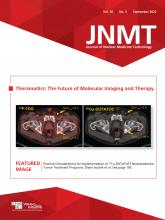Overall, in the past 50+ years, the diagnostic and therapeutic capabilities of nuclear medicine and molecular imaging have significantly advanced thanks to the constant improvement in imaging technology and continuous addition of new diagnostic and therapeutic radiopharmaceuticals. Looking back, we have seen numerous changes. From the early days of planar imaging and limited therapeutic procedures, to the explosive excitement of cardiac imaging in the early 1980s enhanced with SPECT, to the advent of PET radiopharmaceuticals and technology, followed quickly by hybrid technology (SPECT/CT, PET/CT, and PET/MR), and the many therapeutics along the way to treat thyroid disease, blood disorders, inflammatory joint disease, malignant effusions, bone metastasis, non-Hodgkin’s lymphoma, and liver metastasis—yes, we’ve come a long way!
But today, excitement in nuclear medicine and molecular imaging lies in the new frontier of theranostics —a term comprising therapeutics and diagnostics. Theranostics is used to describe the ability to combine a radioactive drug tagged to a receptor found on a tumor cell membrane to image the tumor cell and a therapeutic radionuclide (e.g., 177Lu or 90Y) tagged to the same receptor to target and kill the tumor cell. To highlight the advancements of Theranostics, this issue of JNMT has been dedicated to innovations in this field.
Four continuing articles set the stage for understanding the application of theranostics in a clinical setting. The first article introduces the concept of basic biochemistry and molecular biology as it relates to today’s radiopharmaceuticals (1). Next, Soulek describes the logistical considerations for implementing a 177Lu-DOTATATE program to treat neuroendocrine tumors (2). 177Lu-PSMA is an effective treatment for prostate cancer. Parent et al. highlight the treatment protocol’s benefits and emphasize the need for close internal collaboration for streamlined patient care (3). The final continuing education article focuses on treating osteoblastic osseous metastatic disease for castration-resistant prostate cancer without visceral metastases and the technical issues to consider when implementing this therapeutic protocol (4). Three Practical Protocol Tips (177Lu-DOTATATE, 177Lu-PSMA, and 223Ra-dichloride) follow each of their respective continuing education articles to provide a detailed protocol that can be clipped and incorporated into your procedure manual.
In an Invited Perspective, the Technologist Section’s Advocacy Committee explores required training for the nuclear medicine technologist to successfully participate in current and future theranostic protocols and notes that “nuclear medicine technologists are well‐positioned to take an active lead in theranostics growth and advancement” (5).
Radioiodine is the first theranostic radionuclide used for imaging and therapy; however, the challenges associated with radioiodine therapy are patient-specific in terms of dosimetry and clinical limitations. Kumar et al. (6) summarize the considerations of radioiodine therapy for differentiated thyroid cancer with the clinical limitation of end-stage renal disease, and Oliveira et al. (7) describe the importance of residence time and dosimetry before radioiodine therapy.
Kathy S. Thomas, MHA, CNMT, PET, FSNMMI-TS
When reading time is available, check out the additional topics associated with theranostics in radionuclide therapy, quality and practice management, imaging, radiation safety, and teaching case studies included in this issue.
As always, JNMT continues to look for new topics, clinical research, continuing educational articles, protocols, tips, and pointers. If you have ideas or suggestions or are considering writing but need some help getting started, please contact me at ksthomas0412{at}msn.com. Help is available!! If writing isn’t your thing, but you’re willing to share your expertise by becoming a reviewer for JNMT, please contact me!








